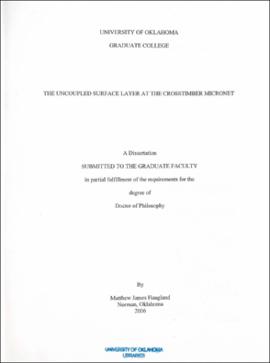| dc.contributor.author | Haugland, Matthew James | |
| dc.coverage.spatial | Oklahoma | |
| dc.date.accessioned | 2022-02-15T14:47:09Z | |
| dc.date.available | 2022-02-15T14:47:09Z | |
| dc.date.created | 2006 | |
| dc.date.issued | 2006 | |
| dc.identifier.uri | https://hdl.handle.net/11244/334596 | |
| dc.description | Thesis (Ph. D.)--University of Oklahoma, 2006. | |
| dc.description | Includes bibliographical references (leaves 110-116). | |
| dc.description.abstract | One of the greatest challenges faced by weather forecasters is the large spatial variability of temperature that occurs at small scales, particularly on clear nights with light wind. The physical processes that create this variability were analyzed using 3 years of meteorological observations from the Crosstimber Micronet, an automated microscale surface observation network in central Oklahoma.
The observations revealed extreme microscale temperature gradients across the Micronet (i .e., > 10°C across less than 200 m of land). These gradients were shown to be created by the unique surface energy balance within a turbulence-free layer of air that sometimes develops near the ground. This layer is called the uncoupled surface layer (USL).
Based on the surface energy budget and parameterizations derived from observations of the USL at the Micronet, the Uncoupled Surface Layer forecast model (USL model) was developed to predict near-surface temperatures on clear nights. The USL model represents a new approach to temperature forecasting that, heretofore, has not been documented in the scientific literature.
Nine diverse locations across central Oklahoma, central California, and southern
California were selected for verification of forecasts by the USL model on clear nights
from June-December 2005. These forecasts were compared with concurrent forecasts by
operational Model Output Statistics (MOS), a well-respected forecasting technique used
operationally for decades.
Forecasts by the USL model were 0.5-4.1°C (21-72%) more accurate than those
by MOS. The largest improvements over MOS were observed at the Crosstimber
Micronet (72%) and Cuyama, California (67%). Both are located in sheltered valleys that
are considered very favorable for development of the USL. The USL model also
substantially outperformed MOS at locations that are considered less favorable for USL
development ( e.g., urban areas along the Pacific Coast).
The accuracy of the USL model confirms that the uncoupled surface layer is an
important feature of the near-surface nocturnal boundary layer at a variety of locations.
The results also suggest that the USL model could lead to significant improvements in
nighttime temperature forecasting. | |
| dc.format.extent | viii, 116 leaves | |
| dc.format.medium | viii, 116 leaves : ill. (some col.), maps (some col.) ; 29 cm. | |
| dc.language.iso | eng | |
| dc.subject.lcsh | Weather forecasting | |
| dc.subject.lcsh | Temperature | |
| dc.subject.lcsh | Meteorology--Oklahoma--Observations | |
| dc.title | The uncoupled surface layer at the Crosstimber Micronet | |
| dc.type | Text | |
| dc.contributor.committeeMember | Luo, Yiqi | |
| dc.contributor.committeeMember | Lamb, Peter | |
| dc.contributor.committeeMember | Fedorovich, Evgeni | |
| dc.contributor.committeeMember | Elliott, Ronald | |
| dc.contributor.committeeMember | Doswell, Charles A. III | |
| dc.contributor.committeeMember | Crawford, Kenneth C. | |
| ou.group | School of Meteorology | |
